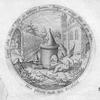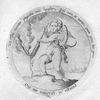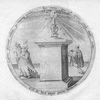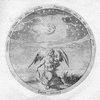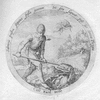Ni spirat immota [9]

Het gheen dat my verheught/ moet ick van buyten haelen/
Het gheen dat my beweeght/ moet van een ander daelen/
Oft anders ben ick still’/ ick moet wel stille staen.
O dat de wint eens quaem soo moght ick wedergaen/
Dat haren adem slechts (den oorspronck van mijn leven)
Wt haren blyden mondt een windeken wou gheven
Op mijn beladen hert/ ten minsten van terzy:
Nu ben ick sonder haer/ nu ben ick sonder my.
Het gheen dat my beweeght/ moet van een ander daelen/
Oft anders ben ick still’/ ick moet wel stille staen.
O dat de wint eens quaem soo moght ick wedergaen/
Dat haren adem slechts (den oorspronck van mijn leven)
Wt haren blyden mondt een windeken wou gheven
Op mijn beladen hert/ ten minsten van terzy:
Nu ben ick sonder haer/ nu ben ick sonder my.

Translations
 |
Zonder wind geen beweging. |
 |
Without wind there is no movement. |
 |
Een windmolen staat onbeweeglijk als er geen wind staat. Zo sta ik stokstijf stil als jouw genade me niet toeblaast. |
 |
A windmill stands motionless if there is no wind. Thus I do not move when your charm does not blow on me. |
Literature
-
Henkel and Schöne, Emblemata
 , col. 1242
, col. 1242
-
Praz, Seventeenth-Century Imagery
 , p. 94
, p. 94
Sources and parallels
- Same emblem in 1601 edition: Ni spirat, immota [9] (in: Daniël Heinsius, Quaeris quid sit Amor (c. 1601))
[Compare
![Compare [compare]](/static/images/compare2.gif) ]
]
- A probable source for the pictura and entire emblem: La Perriëre, Theatre
 , embl. 85
, embl. 85 -
Parallel in the 1616 edition: motto and subscriptio the same, pictura partly mirrored: Ni spirat immota. [33] (in: Daniël Heinsius, Ambacht van Cupido, from: Nederduytsche poemata (1616))
[Compare
![Compare [compare]](/static/images/compare2.gif) ]
]
-
Typical Dutch elements also used by Heinsius in:In lubrico. [20] (in: Daniël Heinsius, Ambacht van Cupido, from: Nederduytsche poemata (1616))
[Compare
![Compare [compare]](/static/images/compare2.gif) ]
]
-
Windmill and sleeping man: Sambucus, Emblemata
 , embl. 75
, embl. 75
-
Typical Dutch elements also used by Cats in:Dominae, quo me vocat, aura. [28] (in: Jacob Cats, Proteus (1618))
[Compare
![Compare [compare]](/static/images/compare2.gif) ]
]
-
Typical Dutch elements also used by Cats in:Dominae, quo me vocat, aura. [29] (in: Jacob Cats, Sinne- en minnebeelden (1627))
[Compare
![Compare [compare]](/static/images/compare2.gif) ]
]
References, across this site, to this page:
- Dominae, quo me vocat, aura. [28] (in: Jacob Cats, Proteus (1618))
- Dominae, quo me vocat, aura. [29] (in: Jacob Cats, Sinne- en minnebeelden (1627))
- Ni spirat, immota [9] (in: Daniël Heinsius, Quaeris quid sit Amor (c. 1601))
- In lubrico. [20] (in: Daniël Heinsius, Ambacht van Cupido (1613))
- Ni spirat immota. [33] (in: Daniël Heinsius, Ambacht van Cupido (1613))
- In lubrico. [20] (in: Daniël Heinsius, Ambacht van Cupido, from: Nederduytsche poemata (1616))
- Ni spirat immota. [33] (in: Daniël Heinsius, Ambacht van Cupido, from: Nederduytsche poemata (1616))
Iconclass
A man leaning against the fence that surrounds a motionless windmill; a woman walking along a path behind him; Cupid flying, taking aim- landscapes in the temperate zone
[25H1]

- floating in the air
[31A2763]

- one of the lovers alone (e.g. longing for the beloved)
[33C216]

- awakening love
[33C218]

- windmill
[47D31]

- Rest, Immobility, Stasis (+ situation or event (especially in genre-painting) with symbolical connotation)
[51LL1(+6)]

- (personifications and symbolic representations of) Love; 'Amore (secondo Seneca)' (Ripa) (+ emblematical representation of
concept)
[56F2(+4)]

- Vitality, Viability, Vital Force (+ emblematical representation of concept)
[58B1(+4)]

- proverbs, sayings, etc. (with TEXT)
[86(NI SPIRAT IMMOTA)]

- Cupid shooting a dart
[92D1521]

![[H O M E : Emblem Project Utrecht]](/static/images/rd-small.gif)




